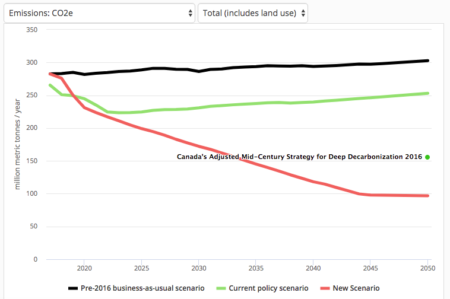Author: Milan
Queen’s Park climate strike
I ducked out of my public policy workshop today to get some photos of the climate strike at Queen’s Park.
There are amazing photos and videos from other cities around the world, with turnouts of tens of hundreds of thousands in European cities. The rally in Montreal also seems to have been huge, for reasons I am very curious about. I would love to know what went into organizing it, and into bringing so many people out.
Bee
Alberta’s Energy Policy Simulator
The Pembina Institute has released a new interactive tool that lets anybody test out alternative approaches to setting energy policy for Alberta, in sectors including transport, buildings, electricity generation, and agriculture.
It doesn’t allow a huge amount of ambition. For instance, the only bitumen sands policy option is the 100 megatonne cap which the Alberta government has proposed, which you can tweak to be implemented more clearly. Still, it does a nice job of illustrating the relative impact of different approaches, from a faster phase-out of coal in electricity generation to various policies targeting vehicles, methane emissions, cement production, and sector-specific carbon taxes up to $350 per tonne.
Even with the most aggressive coal phase-out options, the bitumen sands cap, and $350 carbon taxes in all sectors, projected emissions only fall from a current level around 275 megatonnes of CO2-equivalent to around 100 megatonnes in 2045:
Even if every jurisdiction in the world achieved cuts at that rate, it wouldn’t be fast enough to produce a sub-2 ˚C warming scenario as called for in the Paris Agreement, and any politically plausible global pathway would see countries with very high per capita and historical emissions like Canada cut deeper and faster than the average.
I have previously posted about climate change games/simulations from the BBC and Chevron.
Toronto bulldog art
Skeptical cat garage
Garage graffiti face
Middlebury fossil fuel divesment
At the end of January, Middlebury College (home institution of 350.org founder Bill McKibben) committed to fossil fuel divestment as part of a four-part response to climate change.
As far as I know, this is the first university which had formally said no to a divestment campaign and has since been brought around to saying yes.
Today Laurie Patton, the President of the college, published an editorial in Inside Higher Ed: Every Campus Should Address Climate Risk.
Mean-looking fish
30 papers left
If the plan to finish the PhD by the end of August holds — along with the pattern of never getting a summer TA position — this batch of second year political science papers will be the last undergraduate essay grading I ever do.
That would be most welcome. While there is a nurturing sort of grader who focuses on finding something to approve of in each submission, my approach is to hold firm sets of criteria in mind for each range of grades and then work to fairly assign each paper to the right one based on the ways in which it is insufficient according to the criteria for a higher one.
Actually teaching people how to improve their writing would require a lot more one-on-one interaction than U of T provides. When students want to meet about their papers I set aside an hour for each one, which rapidly becomes unpaid since I am not assigned anywhere near that many hours for student contact. Still, it is worthwhile because it shows how students at every level of skill can benefit from detailed engagement with exactly what is expected in a university paper: whether that is finding a few scattered pieces of an argument that could have been presented in a convincing and well-supported way, or adding more nuance and consideration of counterarguments to a paper than is already very strong.







